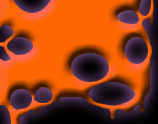ELAPIDAE (cobras and coral snakes)
The cobra family is thought to have evolved from Colubrid snakes and many appear very similar in appearance with long, slender bodies and large scales (plates) on the head. They differ in having more advanced venom delivery systems than the venomous Colubrids. Elapids have fangs that are "effectively tubular" in that the fangs contain grooves that are enclosed by an infolding of the edges. The fangs are in the front of the mouth rather than the rear as is seen in venomous Colubrids. The Elapidae contains some of the world's most dangerous snakes including cobras (Naja), mambas (Dendroaspis) and sea snakes (Hydophinae and Laticaudinae). Elapids are found worldwide and in Ausralia are the predominant family. In North America, three species of elapids are found, two species of coral snakes and one sea snake. The coral snakes are relatively small snakes that spend most of their time underground. Their primary food is other snakes. Despite their small size and small fangs, their venom is extremely toxic.
VIPERIDAE (vipers)
The vipers are generally considered to be the most advanced family of snakes since they possess a very sophisticated venom delivery system. Large tubular fangs are placed in the front of the mouth and they are hinged, allowing them to be folded back when not in use. Their heads are covered with numerous small scales and their eyes have vertically eliptical pupils. All the vipers found in North America are in the subfamily of pit vipers (Crotalinae) having a pair of heat sensing pits located between each eye and nostril. The rattlesnakes are a truly American family of pit vipers since they are not found in the Old World and all but two species are found in the U.S. or Mexico. They are divided between two genera based on their head scales. Members of the genus Crotalus have numerous small scales on their heads while members of the genus Sistrurus have large scales (plates) on their heads.
Scientific and common names from J T Collins, Standard common and current scientific names for North American amphibians and reptiles, Third Edition, Soc Study Amph & Rept Herp Circular No , Order of families from J L Behler and F W King, The Audubon Society Field Guide to North American Reptiles and Amphibians, Alfred A Knopf,
Compiled for Slater Museum of Natural History, University of Puget Sound, Tacoma, WA , by Doug Henderson and Dennis Paulson, October, 1995
More Information on Snakes
Whats the difference between Lampropeltis and Elaphe?
Lampropeltis Information
More Snake Pictures
Corn Snakes Genetics
Snake Identification
Please do not email me asking for help identifying your snake.
I just don't have the time to answer all the emails this site generates. Sorry.
Here's my advice though. Don't kill it! Leave it alone and it will leave you alone.
If you really do want to identify a snake, get a field guide at the library or book store. These will have information on the geopgraphic ranges and that will allow you to narrow your search.
Good luck and thanks for visiting my Snakes of North America page.

